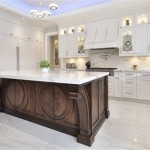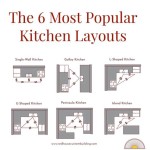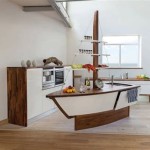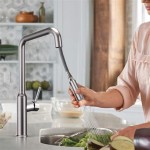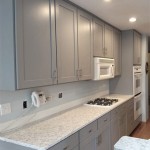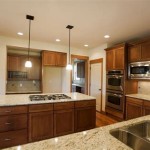How To Choose The Right Hardware For Kitchen Cabinets
Kitchen cabinet hardware may appear to be a minor detail in the overall design, but it significantly contributes to the functionality, aesthetics, and longevity of the cabinetry. Selecting the appropriate hardware involves a careful consideration of various factors, from the style and finish to the ergonomics and durability. A well-chosen hardware suite can elevate the look of a kitchen, making it more user-friendly and enhancing its overall value. Conversely, the wrong hardware can detract from the design, create operational issues, and may require premature replacement.
The process of selecting kitchen cabinet hardware shouldn't be an afterthought; it should be a deliberate part of the kitchen design phase. Considering the hardware early on allows for informed decisions regarding cabinet style, layout, and overall kitchen aesthetic. This article will explore key considerations to guide the selection of appropriate hardware, ensuring a balance of style, functionality, and durability.
Understanding Hardware Types: Knobs, Pulls, and Hinges
Kitchen cabinet hardware generally falls into three main categories: knobs, pulls (or handles), and hinges. Each category serves a distinct purpose and offers a wide range of styles and functionalities.
Knobs are typically smaller, single-point attachment hardware. They are often used on cabinet doors and smaller drawers. Knobs are generally considered a more traditional or classic hardware choice. They come in a vast array of shapes, sizes, and materials, ranging from simple round knobs to more ornate designs featuring intricate details. Their simplicity often makes them a budget-friendly option.
Pulls, also known as handles, are longer and typically have two points of attachment. They are commonly used on larger drawers and cabinet doors, providing a more substantial grip. Pulls come in various styles, including bar pulls, arch pulls, cup pulls, and recessed pulls. The style of pull can significantly impact the overall aesthetic of the kitchen, from modern and minimalist to rustic and traditional. They offer better leverage than knobs, which is beneficial for heavier or frequently used drawers.
Hinges are the unsung heroes of cabinet hardware. They connect the cabinet door to the cabinet frame, allowing the door to swing open and closed. The type of hinge used will impact the swing of the door, its adjustability, and its overall durability. Concealed hinges, also known as European hinges, are mortised into the cabinet door and frame, providing a clean, seamless look. Exposed hinges are visible on the exterior of the cabinet and can be chosen to complement the overall style. Self-closing hinges add convenience, ensuring that doors close fully and prevent slamming.
Choosing the right combination of knobs and pulls, or a consistent style throughout, depends on personal preference and the overall design aesthetic. A general guideline is to use knobs on doors and pulls on drawers, especially larger or heavier drawers. However, mixing and matching can create a unique and personalized look. Consideration should be given to the ergonomics of each hardware piece – ensuring a comfortable grip and ease of use for all users.Matching Hardware Style to Kitchen Design
The style of kitchen cabinet hardware should complement and enhance the overall design aesthetic of the kitchen. Selecting hardware that clashes with the style of the cabinets or the kitchen's overall design can detract from the look and feel of the space. Understanding the different design styles and how hardware can contribute to them is crucial for making informed decisions.
Traditional kitchens often feature ornate details, warm tones, and classic design elements. For traditional kitchens, hardware with intricate designs, antique finishes, and classic shapes is often a good choice. Oil-rubbed bronze, antique brass, and pewter finishes can complement the warm tones and traditional style. Knobs and pulls with decorative detailing, such as rosettes, beading, or raised panels, can enhance the traditional aesthetic.
Modern kitchens typically embrace clean lines, minimalist design, and a focus on functionality. Hardware for modern kitchens should reflect these principles. Sleek bar pulls, minimalist knobs, and geometric shapes are popular choices. Chrome, brushed nickel, and stainless steel finishes are often used to complement the clean lines and modern aesthetic. Recessed pulls can also be a good option for a minimalist look, as they are flush with the cabinet surface.
Contemporary kitchens blend elements of both traditional and modern design. This allows for more flexibility in hardware selection. Hardware with clean lines but a slightly softer edge, or a combination of modern finishes with more traditional shapes, can work well in contemporary kitchens. Two-toned hardware, combining different materials or finishes, can also add visual interest to a contemporary kitchen.
Rustic kitchens often feature natural materials, distressed finishes, and a warm, inviting atmosphere. Hardware for rustic kitchens should reflect these elements. Wrought iron, hammered copper, and antique brass finishes are popular choices. Knobs and pulls with a textured or distressed finish can enhance the rustic aesthetic. Simple, sturdy designs are often preferred over ornate details.
Beyond these primary styles, there are many other kitchen design styles to consider, such as transitional, farmhouse, and eclectic. The key is to select hardware that complements the overall style and enhances the desired aesthetic. Considering the color palette of the kitchen is also important. The hardware finish should complement the cabinet color, countertops, and backsplash.
Durability and Functionality: Material and Finish Considerations
Beyond aesthetics, the durability and functionality of kitchen cabinet hardware are crucial factors to consider. The material and finish of the hardware will impact its resistance to wear and tear, corrosion, and tarnishing. Choosing materials and finishes that are appropriate for the kitchen environment will ensure that the hardware lasts for years to come.
Common hardware materials include zinc, brass, stainless steel, and aluminum. Zinc is a cost-effective option that is often used for knobs and pulls. It is relatively durable and can be finished in a variety of colors and styles. Brass is a more expensive material that is known for its durability and resistance to corrosion. It is a popular choice for high-end hardware. Stainless steel is a highly durable and corrosion-resistant material that is often used in modern kitchens. Aluminum is a lightweight and corrosion-resistant material that is often used for contemporary hardware.
Popular hardware finishes include chrome, brushed nickel, oil-rubbed bronze, antique brass, and matte black. Chrome is a shiny, reflective finish that is easy to clean and maintain. It is a popular choice for modern kitchens. Brushed nickel is a satin finish that is less reflective than chrome and is more forgiving of fingerprints and water spots. It is a versatile choice that can work well in both modern and traditional kitchens. Oil-rubbed bronze is a dark, warm finish that adds a touch of elegance to traditional kitchens. Antique brass is a similar finish that has a slightly more aged appearance. Matte black is a modern, bold finish that is becoming increasingly popular. It can add a dramatic touch to any kitchen.
The kitchen is a high-traffic area that is exposed to moisture, grease, and cleaning products. Therefore, it is important to choose hardware materials and finishes that are resistant to these elements. Stainless steel and brass are generally the most durable and corrosion-resistant options. Finishes such as chrome and brushed nickel are also relatively easy to clean and maintain. Avoid finishes that are prone to tarnishing or chipping, as these will require more frequent maintenance and may not last as long.
The way hardware is used can affect the choice of material in certain applications. For example, frequently used drawers will benefit from sturdy pulls made from a durable material like stainless steel. Using handles on heavy pan drawers will also provide a more secure and comfortable grip. The overall weight of the cabinet doors may also influence hinge selection. Heavier doors may need heavier duty hinges to ensure smooth operation.
Ergonomics and Accessibility
Ergonomics and accessibility are important considerations when selecting kitchen cabinet hardware, particularly for individuals with mobility issues or those who plan to age in place. The hardware should be easy to grip and operate, even with wet or slippery hands. It is important to consider the size, shape, and placement of the hardware to ensure that it is comfortable and accessible for all users.
Size and shape are crucial for ensuring a comfortable grip. Knobs should be large enough to grip easily without being too bulky. Pulls should have adequate space to accommodate fingers and knuckles. Ergonomic pulls with curved or contoured shapes can be more comfortable to grip than straight pulls. For individuals with arthritis or other hand limitations, lever-style pulls may be a better option, as they require less force to operate.
Hardware accessibility is concerned with the height and placement of hardware. Hardware should be installed at a comfortable height for all users. For individuals in wheelchairs, lower placement may be necessary. It is also important to ensure that there is adequate space around the hardware to allow for easy access. Avoid placing hardware in tight corners or behind obstructions. Consider using touch-latch mechanisms for upper cabinets, eliminating the need for pulling at all.
Beyond the physical dimensions, consider the user experience. The hardware should be smooth and easy to operate, without any sharp edges or rough surfaces. Test the hardware before purchasing to ensure that it is comfortable and easy to use. Consult with a kitchen designer or occupational therapist for guidance on selecting hardware that is appropriate for your specific needs.
Budget Considerations
Kitchen cabinet hardware costs can vary significantly, depending on the material, finish, style, and brand. Setting a budget for hardware is important to avoid overspending and to ensure that you are making informed decisions. It is possible to find stylish and functional hardware at a variety of price points.
Simple knobs and pulls made from zinc or aluminum are generally the most affordable options. More expensive materials, such as brass and stainless steel, and more intricate designs will typically cost more. Finishes can also impact the price. Specialty finishes, such as oil-rubbed bronze or antique brass, often cost more than standard finishes, such as chrome or brushed nickel. Budget-friendly options can still offer solid build quality and aesthetic appeal if chosen wisely.
Shopping around and comparing prices from different retailers can help find the best deals. Consider purchasing hardware in bulk to take advantage of discounts. Online retailers often offer lower prices than brick-and-mortar stores. Look for sales and clearance items to save even more money. If a DIY installation is possible, this may offset the costs of higher-end hardware.
While it is important to stay within budget, it is also important not to compromise on quality. Choosing cheap, low-quality hardware can result in premature wear and tear, requiring frequent replacement. Investing in durable hardware from a reputable brand will ultimately save money in the long run. Consider focusing the budget on high-use cabinets hardware and choosing less expensive options for less frequently used areas.

6 Tips To Choose The Right Cabinet Hardware Signature Home Services

How To Choose The Right Kitchen Cabinet Hardware

Knobs Pulls How To Choose The Right Kitchen Cabinet Hardware Riverstone Kitchens Calgary Custom Cabinetry Renovations

How To Choose Beautiful Cohesive Hardware For Your Home Ckd Remodeling

Choosing The Right Cabinet Hardware All My Best Advice For Homeowners

How To Choose The Right Hardware For Your Kitchen New Hampshire Home

Choosing The Right Finishes For Cabinet Handles Pulls And Knobs Christopher Scott Cabinetry

How To Choose The Right Hardware For Kitchen Cabinets N Hance

How To Choose Kitchen Cabinet Hardware In 6 Easy Steps

How To Choose Beautiful Cohesive Hardware For Your Home Ckd Remodeling
Related Posts

